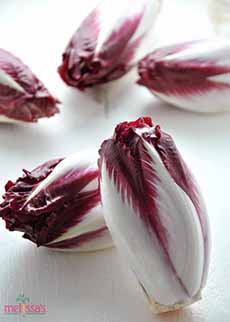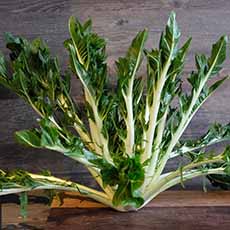TIP OF THE DAY: Buy Some Chicory
|
It’s winter, where produce options are limited. But there’s still much to discover. Take the chicory family. Can you name three chicories? (Check the photos at right.) They are cool weather crops that come into season in late fall, and last through early spring. Much more popular in Europe than in the U.S.*, the chicory family is a large one. There are many varieties across the world. Each differs in appearance, color, and to some extent, flavor. The heads can be loose-leafed or tightly-headed, tapered or round, smooth-leaved or frilled. The colors range from the purest white and pale yellow, to bright green and maroon. All share a slightly bitter taste. The varieties best-known in the U.S. are: Chicories are closely related to lettuces, but heartier, with a bitter edge. More than a few Americans don’t seem to like chicories, possibly due to their bitterness. Perhaps in our country, where sugar is dumped into everything from bread to mustard and the government has looked at regulating the excessive amount of salt in prepared foods, people have been weaned away from the bitter flavor. Bitter is one of the five tastes, along with salty, sour, sweet and umami. Give it a chance. And check out the next section. The easiest way to soften the bitterness in chicories is to shock them in an ice bath. Chicories shine in salads, and you can add or pair nuts, fruits or rich cheeses. But their hardiness also lends themselves to braises, sautéed and roasted dishes, grilling, even turned into soup. Two favorites: FOOD TRIVIA #1: The roots of most chicory plant varieties have long been used as a coffee substitute. It’s naturally caffeine free. In the 19th century it was used as a coffee additive to stretch limited supplies of coffee; substitute became widespread in France and in some of the French colonies, like New Orleans. The roots are roasted, ground, and combined with coffee to create the chicory coffee enjoyed in Creole cuisine. During the Civil War, when coffee was unattainable in the South, chicory became the substitute drink. (We’ve had it in New Orleans; it’s a nutritious drink but an acquired taste.) FOOD TRIVIA #2: What Americans call endive, the British call chicory; and what the Americans call chicory, the British call endive [source]. |
|
|
 [8] Some of the chicory varieties (photo © Good Eggs). *When we were quite young, our family patronized an Italian restaurant, where the “house salad” was made with escarole, instead of the then-popular iceberg lettuce. Mother did not approve.
|
||






